Created 06/2016 | Download PDF
INTRODUCTION
Currently, 1.9 million people are living with limb loss in the United States (1). An estimated 185,000 amputations are performed each year (2). The number of people living with limb loss is expected to double by the year 2050 due to increasing rates of diabetes and vascular disease (3). Among those living with limb loss, the major causes of amputation are vascular disease (54%) – including diabetes and peripheral arterial disease – trauma (45%) and cancer (less than 2%) (4). The most common causes of pediatric amputations, however, are lawn mower accidents (5). Non-whites comprise about 42% of the limb loss population in the U.S. (3). In 2008, the diabetes related amputation rate among African Americans was nearly four times that of whites (6).
A total of 410 amputations were performed in North Dakota hospitals in 2013. These amputations were performed for a variety of reasons, including diabetes. The following information highlights the trends and most current rates of amputation and diabetes in North Dakota.
1. AMPUTATION TRENDS
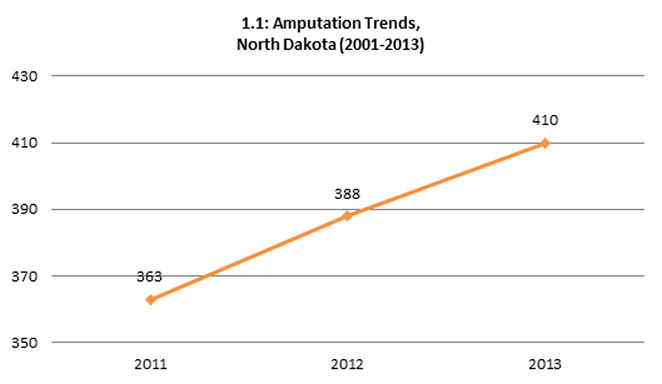
Source: Healthcare Cost and Utilization Project HCUPnet database hcupnet.ahrq.gov
There was an overall 12.95% increase in total amputations performed in North Dakota from 2011-2013 according to hospital discharge data. A total of 1,161 amputation procedures were performed in this time period. The lowest incidence of amputation (363) was in 2011. The highest incidence (410) was in 2013. (See Graph 1.1)
The number of upper-extremity amputations performed each year decreased 30.23% from 2001 to 2013. A total of 112 upper-extremity amputation procedures were performed in this time period. The lowest incidence of these amputations (30) occurred in 2013, while 2011 saw the most upper-extremity amputations (43). (See Graph 1.2)
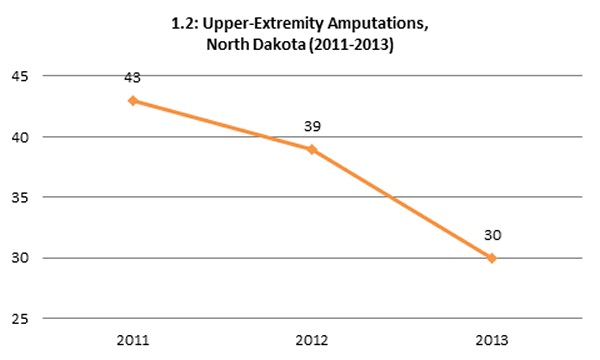
Source: Healthcare Cost and Utilization Project HCUPnet database hcupnet.ahrq.gov
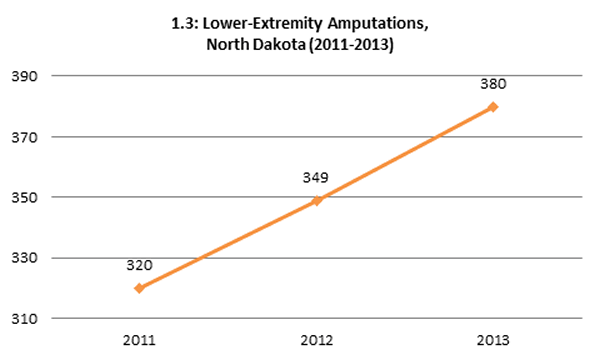
Source: Healthcare Cost and Utilization Project HCUPnet database hcupnet.ahrq.gov
The number of lower-extremity amputations performed each year increased 18.75% from 2011 to 2013. A total of 1,049 lower-extremity amputation procedures were performed in this time period. The lowest incidence of these amputations (320) occurred in 2011. The highest incident year (3880) was in 2013. (See Graph 1.3)
2. TYPES OF AMPUTATIONS PERFORMED
There were 27 upper-extremity amputations were performed in 2013. The most common minor upper-extremity amputations were of the fingers (27) and there were no major upper extremity amputations reported. (See Graph 2.1)
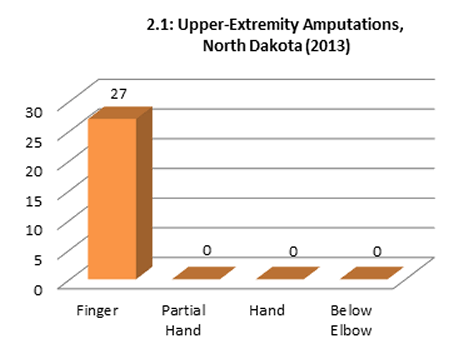
Source: Healthcare Cost and Utilization Project HCUPnet database hcupnet.ahrq.gov
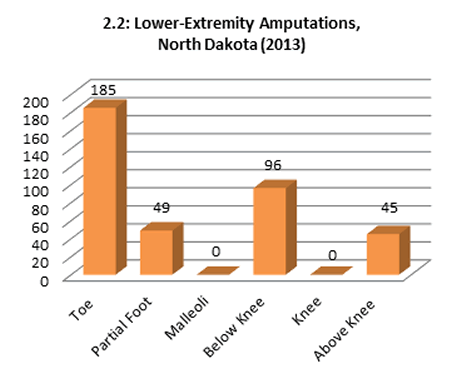
Source: Healthcare Cost and Utilization Project HCUPnet database hcupnet.ahrq.gov
In 2013, 375 lower-extremity amputations were performed. Amputations of the toes (185) were the most frequent minor lower extremity amputation type. Below (96) and above (45) the knee were the most common major lower extremity amputation procedures. (See Graph 2.2)
3. WHO LOSES A LIMB?
In 2013, most amputations were performed on individuals aged 45-64 years old, followed by the age group of 65-84 year olds (See Graph 3.1).
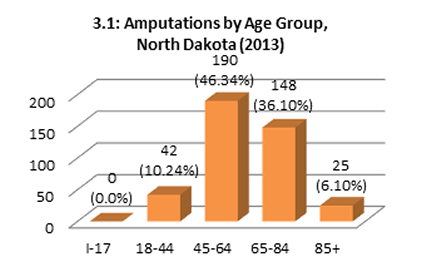
Source: Healthcare Cost and Utilization Project HCUPnet database hcupnet.ahrq.gov
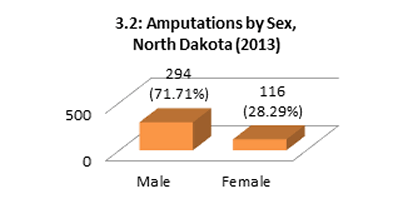
Source: Healthcare Cost and Utilization Project HCUPnet database hcupnet.ahrq.gov
The amputation rate among males was more than twice that of females (See Graph 3.2).
Medicare recipients ranked as the most common group to have an amputation procedure (See Graph 3.3).
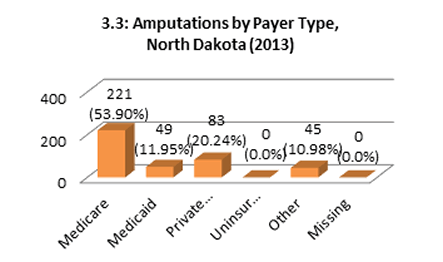
Source: Healthcare Cost and Utilization Project HCUPnet database hcupnet.ahrq.gov
4. DIABETES TRENDS
In 2013, a total of 49,783 people in North Dakota indicated that they had been diagnosed with diabetes at some point in their lives. The prevalence of diabetes in the adult population of North Dakota increased 194.1% from 1994 to 2013. (See Graph 4.1)
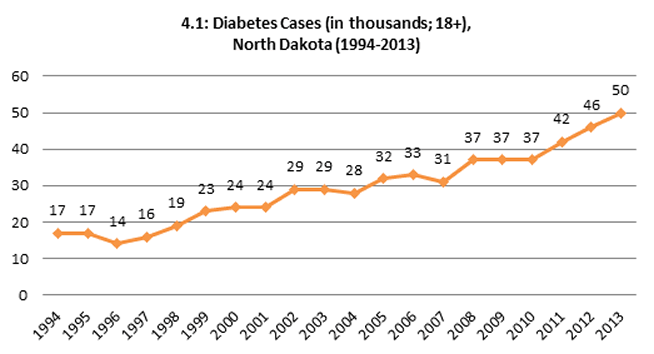
Source: CDC Behavioral Risk Factor Surveillance System
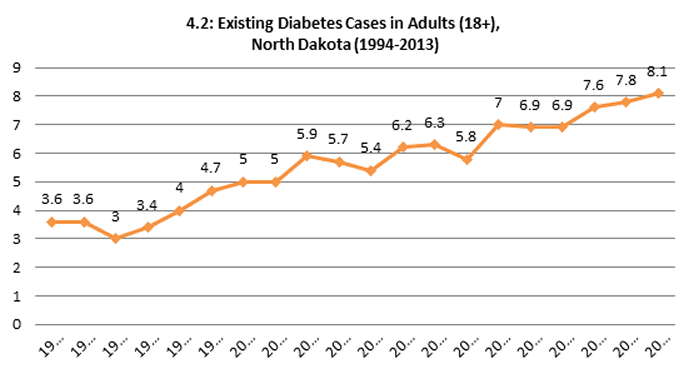
The annual rate of existing cases of diabetes among adults in North Dakota increased 125% from 1994 to 2013. (See Graph 4.2)
5. HEALTHCARE COSTS
For persons with a unilateral lower-extremity amputation, the two year healthcare costs, including initial hospitalization, inpatient rehabilitation, outpatient physical therapy, and purchase and maintenance of a prosthetic device, is estimated to be $91,106. The lifetime healthcare cost for persons with a unilateral lower extremity amputation is estimated to be more than $500,000 (7). It is anticipated that these healthcare costs would be higher for a person with a proximal amputation level and bilateral amputation status, due to higher prosthetic costs
Charges represent what the hospital billed for the case, and may not represent all discharges for amputations. (See graph 5.1)
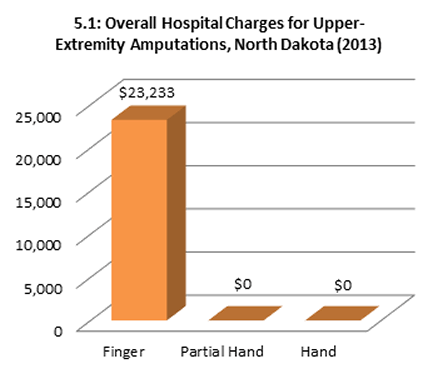
Source: Healthcare Cost and Utilization Project HCUPnet database hcupnet.ahrq.gov
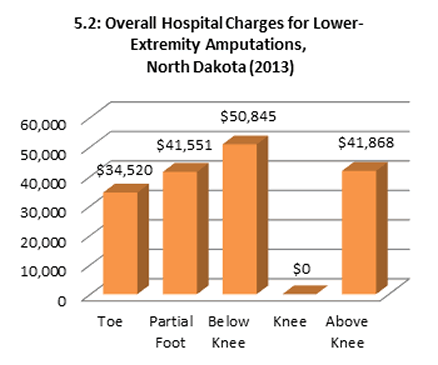
Source: Healthcare Cost and Utilization Project HCUPnet database hcupnet.ahrq.gov
Charges represent what the hospital billed for the case, and may not represent all discharges for amputations. (See graph 5.2)
6. REFERENCES
- Ziegler-Graham K, MacKenzie EJ, Ephraim PL, Travison TG, Brookmeyer R. Estimating the prevalence of limb loss in the United States: 2005 to 2050. Arch Phys Med Rehabil2008 Mar;89(3):422-9.
- Adams PF, Hendershot GE, Marano MA. Current estimates from the National Health Interview Survey, 1996. Vital and health statistics Series 10, Data from the National Health Survey1999 Oct(200):1-203.
- Ziegler-Graham K, MacKenzie EJ, Ephraim PL, Travison TG, Brookmeyer R. Estimating the Prevalence of Limb Loss in the United States: 2005 to 2050. Archives of Physical Medicine and Rehabilitation2008;89(3):422-9.
- Coalition LLTFA. Recommendations from the 2012 Limb Loss Task Force: Roadmap for Preventing Limb Loss in America. [White Paper]. 2012 February 9-12.
- Bryant PR, Pandian G. Acquired limb deficiencies. 1. Acquired limb deficiencies in children and young adults. Archives of Physical Medicine and Rehabilitation2001;82(3B):00s3-s8.
- Li Y, Burrows NR, Gregg EW, Albright A, Geiss LS. Declining rates of hospitalization for nontraumatic lower-extremity amputation in the diabetic population aged 40 years or older: U.S., 1988-2008. Diabetes Care2012 Feb;35(2):273-7.
- MacKenzie EJ. Health-Care Costs Associated with Amputation or Reconstruction of a Limb-Threatening Injury. The Journal of Bone and Joint Surgery (American)2007;89(8):1685.
It is not the intention of the Amputee Coalition to provide specific medical or legal advice but rather to provide consumers with information to better understand their health and healthcare issues. The Amputee Coalition does not endorse any specific treatment, technology, company, service or device. Consumers are urged to consult with their healthcare providers for specific medical advice or before making any purchasing decisions involving their care.
© Amputee Coalition. Local reproduction for use by Amputee Coalition constituents is permitted as long as this copyright information is included. Organizations or individuals wishing to reprint this article in other publications, including other websites must contact the Amputee Coalition for permission to do so, by emailing a request to rc@amputee-coalition.org.



